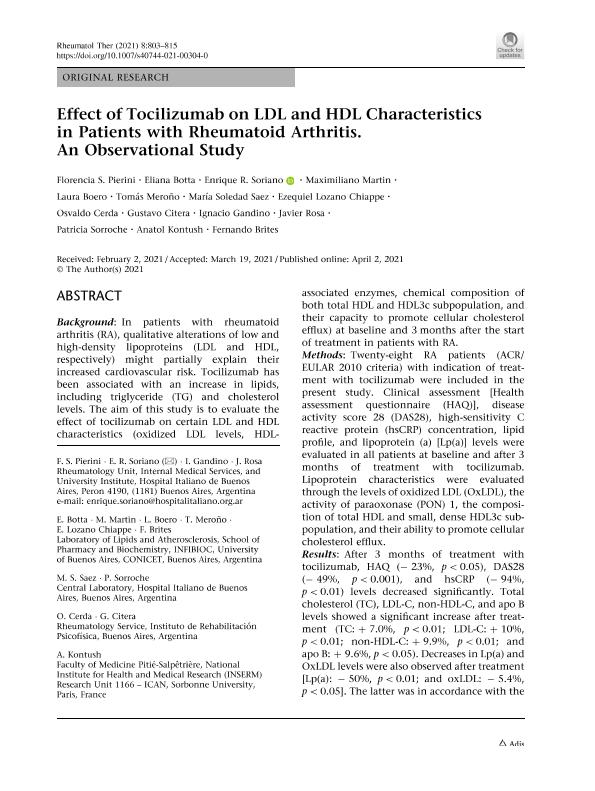Artículo
Effect of Tocilizumab on LDL and HDL Characteristics in Patients with Rheumatoid Arthritis. An Observational Study
Pierini, Florencia S.; Botta, Eliana Elizabeth ; Soriano Guppy, Enrique Roberto; Martin, Maximiliano Emanuel
; Soriano Guppy, Enrique Roberto; Martin, Maximiliano Emanuel ; Boero, Laura Estela; Meroño, Tomás
; Boero, Laura Estela; Meroño, Tomás ; Saez, María Soledad; Lozano Chiappe, Ezequiel Silvano; Cerda, Osvaldo; Citera, Gustavo; Gandino, Ignacio; Rosa, Javier; Sorroche, Patricia; Kontush, Anatol; Brites, Fernando
; Saez, María Soledad; Lozano Chiappe, Ezequiel Silvano; Cerda, Osvaldo; Citera, Gustavo; Gandino, Ignacio; Rosa, Javier; Sorroche, Patricia; Kontush, Anatol; Brites, Fernando
 ; Soriano Guppy, Enrique Roberto; Martin, Maximiliano Emanuel
; Soriano Guppy, Enrique Roberto; Martin, Maximiliano Emanuel ; Boero, Laura Estela; Meroño, Tomás
; Boero, Laura Estela; Meroño, Tomás ; Saez, María Soledad; Lozano Chiappe, Ezequiel Silvano; Cerda, Osvaldo; Citera, Gustavo; Gandino, Ignacio; Rosa, Javier; Sorroche, Patricia; Kontush, Anatol; Brites, Fernando
; Saez, María Soledad; Lozano Chiappe, Ezequiel Silvano; Cerda, Osvaldo; Citera, Gustavo; Gandino, Ignacio; Rosa, Javier; Sorroche, Patricia; Kontush, Anatol; Brites, Fernando
Fecha de publicación:
06/2021
Editorial:
Springer
Revista:
Rheumatology and Therapy
ISSN:
2198-6576
e-ISSN:
2198-6584
Idioma:
Inglés
Tipo de recurso:
Artículo publicado
Clasificación temática:
Resumen
Background In patients with rheumatoid arthritis (RA), qualitative alterations of low and high-density lipoproteins (LDL and HDL, respectively) might partially explain their increased cardiovascular risk. Tocilizumab has been associated with an increase in lipids, including triglyceride (TG) and cholesterol levels. The aim of this study is to evaluate the effect of tocilizumab on certain LDL and HDL characteristics (oxidized LDL levels, HDL-associated enzymes, chemical composition of both total HDL and HDL3c subpopulation, and their capacity to promote cellular cholesterol efflux) at baseline and 3 months after the start of treatment in patients with RA. Methods Twenty-eight RA patients (ACR/EULAR 2010 criteria) with indication of treatment with tocilizumab were included in the present study. Clinical assessment [Health assessment questionnaire (HAQ)], disease activity score 28 (DAS28), high-sensitivity C reactive protein (hsCRP) concentration, lipid profile, and lipoprotein (a) [Lp(a)] levels were evaluated in all patients at baseline and after 3 months of treatment with tocilizumab. Lipoprotein characteristics were evaluated through the levels of oxidized LDL (OxLDL), the activity of paraoxonase (PON) 1, the composition of total HDL and small, dense HDL3c subpopulation, and their ability to promote cellular cholesterol efflux. Results After 3 months of treatment with tocilizumab, HAQ (− 23%, p < 0.05), DAS28 (− 49%, p < 0.001), and hsCRP (− 94%, p < 0.01) levels decreased significantly. Total cholesterol (TC), LDL-C, non-HDL-C, and apo B levels showed a significant increase after treatment (TC: + 7.0%, p < 0.01; LDL-C: + 10%, p < 0.01; non-HDL-C: + 9.9%, p < 0.01; and apo B: + 9.6%, p < 0.05). Decreases in Lp(a) and OxLDL levels were also observed after treatment [Lp(a): − 50%, p < 0.01; and oxLDL: − 5.4%, p < 0.05]. The latter was in accordance with the increment detected in PON activity. No changes were observed in HDL capacity to promote cholesterol efflux (p > 0.05) in the whole group. Conclusions Treatment with tocilizumab reduced hsCRP levels and displayed positive effects on certain lipoprotein-related parameters, such as a potent decrease inLp(a) and a reduction in OxLDL levels. Moreover, HDL capacity to promote cellular cholesterol efflux was maintained after 3 months of treatment.
Palabras clave:
TOCILIZUMAB
,
RHEUMATOID ARTHRITIS
,
LIPIDS
,
HDL
Archivos asociados
Licencia
Identificadores
Colecciones
Articulos(OCA HOUSSAY)
Articulos de OFICINA DE COORDINACION ADMINISTRATIVA HOUSSAY
Articulos de OFICINA DE COORDINACION ADMINISTRATIVA HOUSSAY
Citación
Pierini, Florencia S.; Botta, Eliana Elizabeth; Soriano Guppy, Enrique Roberto; Martin, Maximiliano Emanuel; Boero, Laura Estela; et al.; Effect of Tocilizumab on LDL and HDL Characteristics in Patients with Rheumatoid Arthritis. An Observational Study; Springer; Rheumatology and Therapy; 8; 2; 6-2021; 803-815
Compartir
Altmétricas



